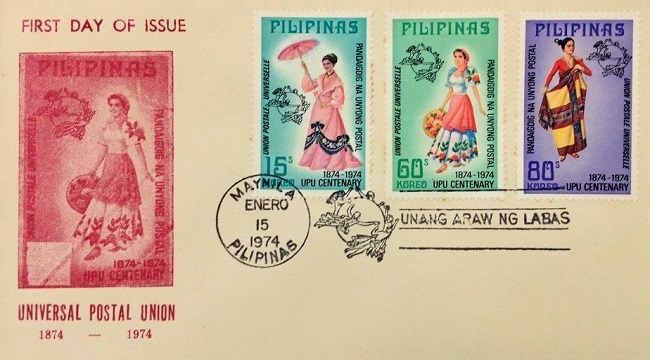

On December 7, 1853, Spanish Governor General Antonio de Urbiztondo ordered the establishment of prepaid postage for all mail, beginning 1 February 1854. Records show that in 1791 the limited mail transmission was already carried on in a limited manner by the Spanish Government.Īn 1887 telegraph stamp of the Philippines. A crude form of postal services in the country existed before that date.
#Philippine envelope stamp surrender day una pagsuko stamp free
No personnel expenses were necessary to maintain this system, as badageros rendered their services free to the Colonial Government.Ī letter postmarked Augin Madrid was received and cancelled in Manila on Apor a matter of 245 days.īefore February 1, 1854, the use of postage stamps was unknown. en estos Dominion, Superentendente General Subdelegado de Real Hacienda, y Renta de Correo". On the titles and official duties of one Capitan General Don Felix Berenguer De Marquina, who executed a documentary appointment in 1791, his titles and duties were listed, viz "Brigadier De La Real, General de estas Islas Filipinas, Presidente de su Real Audencia y Caancelleria, Director General de las Tropas de S.M. In some cases, it took from one to two months before a communication reached the recipient.Īdhesive postage stamps were apparently issued in the Islands before 1854, but the existence of a postal service was clearly evident. A letter or communication might change hands many times depending upon the number of Poblaciones between the origin and the destination.

Letters, communications, and document sheets were just folded. Important papers such as appointments from the Capitan General ( Governor General), were receipted with signatures of the appointees and others present as witnesses.Įnvelopes were unknown during early times. Upon delivery to the next tribunal, the recipient was required to sign on a booklet to show receipt like special delivery/ registered mail. If letters or communications were urgent, the badageros had to go and dispatch them even at midnight.Īrmed guards ( Polistos) wre posted at the outskirts of every poblacion and when challenged by the guards at night, the couriers responded with badageros and the guards would allow them to pass. Two badageros were assigned every day at the Tribunal to be relieved the next day. Badageros performed their courier services by rotation. The badageros were also called Polistos, classified as male citizens over 18 years who did not hold a public office like the Gobernadorcillo ( Mayor), Teniente primero y segundo ( vice-mayor), the Juez, Cabesas (councilors), the Commesarios and Cuadrillos ( Policeman) and Escribanos (clerks). Badageros either hiked or rode on horseback in dispatching the early postal service from "Tribunal (town hall) to tribunal or to the "Casa Real" (provincial capital). Letters, communications and documents were carried by badageros who rendered free services to the colonial government. The Philippines joined the Universal Postal Union as a sovereign entity, on January 1, 1922.ĭuring the early Spanish regime, exchange of letters and communications was limited to those belonging to government officials and Catholic Church officials.

It was later organized as a bureau under the Department of Trade and Industry, then known as the Department of Trade, on September 5, 1902. Spain joined the Universal Postal Union in 1875, which was announced two years later.ĭuring the Philippine Revolution, President Emilio Aguinaldo ordered the establishment of a postal service. Manila became known as a leading center of postal services within Asia. The postal district was reestablished on December 5, 1837. The galleon declined in importance after that and in 1821 was discontinued altogether.In 1767, the first post office was established in Manila, which was later organized as a postal district of Spain, encompassing Manila and the Philippine archipelago, in 1779. The galleon also was the exclusive official carrier of the mails until 1766 when the king authorized ships traveling eastward from Manila also to transport mail. Throughout this period, its major connection with the outside world were the galleons - in their heyday the largest wooden sailing ships ever constructed - which sailed each summer under armed escort from Manila to Acapulco laden with silks and valuables. In 1543, the Spanish named the islands after King Philip II and in 1565 they established their first successful settlement.įrom 1565 until 1821, the Philippines were governed by the Viceroyalty of New Spain (Mexico). This major milestone linked the Spanish explorers approaching Asia from the Americas with the Portuguese from the Indian Ocean. Magellan discovered this 7,600-island archipelago in1521. Currency: 100 centavos / sentimos = 1 Peso / Piso


 0 kommentar(er)
0 kommentar(er)
